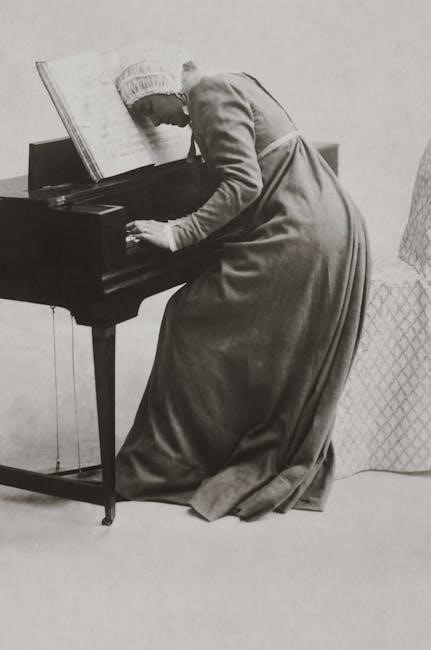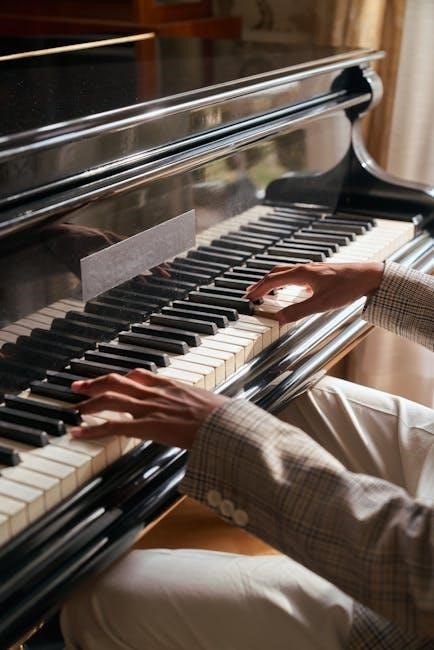The Virtuoso Pianist by Charles-Louis Hanon is a renowned collection of 60 exercises designed to enhance pianists’ speed, precision, and finger independence. Available as a free PDF, it remains a cornerstone of piano technique training, offering comprehensive drills for skill development and musical mastery.
Overview of the Work
The Virtuoso Pianist, composed by Charles-Louis Hanon, is a comprehensive collection of 60 exercises designed to enhance pianists’ technical proficiency. First published in 1873, this method is celebrated for its systematic approach to developing finger strength, dexterity, and precision. The exercises are structured to improve speed, agility, and control, making it an essential tool for pianists of all levels. Available as a free PDF, the work has been widely adopted in piano education, offering a foundation for mastering complex repertoire. Its enduring popularity lies in its ability to address technical challenges while fostering musical expression, solidifying its place as a cornerstone of piano training.
Historical Context and Publication
The Virtuoso Pianist by Charles-Louis Hanon was first published in 1873 in Boulogne, France. This groundbreaking work quickly gained recognition for its systematic approach to piano technique, becoming a staple in musical education. Originally written in French, it has been translated into multiple languages, reflecting its global influence. The exercises were designed to address the technical demands of Romantic-era music, emphasizing finger independence, strength, and precision. Its publication marked a significant milestone in piano pedagogy, offering a structured method for pianists to master advanced techniques. Today, it remains widely used, with free PDF versions readily available, ensuring its legacy endures in modern piano training.
Structure and Content of the Exercises
The Virtuoso Pianist comprises 60 exercises divided into three parts, each targeting specific technical skills. Part I focuses on preparatory exercises for agility and finger independence. Part II introduces more complex techniques, while Part III contains virtuosic studies. Each exercise is carefully structured to build strength, precision, and dexterity, with clear fingering guidance. The exercises progress in difficulty, ensuring a gradual mastery of skills. Available as a free PDF, the collection includes scales, arpeggios, and chromatic drills, making it a comprehensive resource for pianists seeking to enhance their technical proficiency and musical control. Its systematic approach remains unparalleled in piano education.

Hanon’s Biography and Contributions to Piano Technique
Charles-Louis Hanon (1819-1900), a French composer and piano teacher, revolutionized technical training with The Virtuoso Pianist. His method, available as a free PDF, remains essential for building finger strength and precision, shaping modern piano education globally.
Charles-Louis Hanon: A Brief Biography
Charles-Louis Hanon (1819-1900) was a French composer, pianist, and teacher renowned for his contributions to piano technique. Born in Renescure, France, Hanon dedicated his life to music education, developing methods to improve finger dexterity and strength. His most famous work, The Virtuoso Pianist, comprising 60 exercises, was first published in 1873 and remains a cornerstone of piano training. Available today as a free PDF, it has been translated into multiple languages, reflecting its global influence. Hanon’s legacy endures as a pioneer in technical piano studies, shaping generations of pianists and educators worldwide.
Hanon’s Approach to Piano Technique
Charles-Louis Hanon’s approach to piano technique emphasizes systematic exercises to develop finger independence, strength, and dexterity. His method, outlined in The Virtuoso Pianist, consists of 60 exercises designed to target specific technical challenges. Hanon believed in repetitive practice to build precision and speed, focusing on scales, arpeggios, and chromatic scales. His exercises progress from simple to complex, ensuring gradual mastery. Available as a free PDF, Hanon’s work remains a standard in piano education, though some critics argue its repetitive nature may lack musicality. Despite this, his method continues to be widely used for building foundational technical skills.
The Significance of “The Virtuoso Pianist” in His Legacy
Charles-Louis Hanon’s The Virtuoso Pianist is his most enduring contribution to piano pedagogy. This collection of exercises has become a cornerstone in technical training, celebrated for its systematic approach to building finger dexterity and strength. Its widespread adoption and continued relevance solidify Hanon’s legacy as a pioneer in piano technique. The work remains indispensable for pianists seeking to master foundational skills, ensuring Hanon’s influence persists in modern piano education.

The Exercises: Purpose and Benefits
Hanon’s exercises aim to develop finger strength, dexterity, and precision while improving speed and control. They provide a structured approach to technical mastery, benefiting pianists of all levels. The availability of PDF versions ensures easy access to these timeless drills, enhancing practice efficiency and musical proficiency.
Development of Finger Strength and Dexterity
Hanon’s exercises are specifically designed to build finger strength and dexterity through repetitive, targeted drills. Each exercise focuses on individual finger development, ensuring even growth and coordination. The PDF versions of these exercises provide clear fingering guidance, making them accessible for self-study; By practicing these etudes, pianists can achieve greater control, precision, and agility, which are essential for mastering complex repertoire. The structured progression of difficulty in the exercises ensures a steady improvement in technical proficiency, making them a valuable resource for pianists at all skill levels. Regular practice fosters muscle memory and enhances overall finger independence, which is crucial for advanced techniques.
Improving Speed and Precision
Hanon’s exercises are renowned for their ability to enhance speed and precision through systematic practice. The structured drills, such as chromatic scales and arpeggios, target finger accuracy and dexterity. By focusing on controlled movements and rhythmic consistency, pianists can gradually increase tempo while maintaining clarity. The PDF versions of these exercises provide clear fingering guidance, aiding in precise execution. Regular practice fosters muscular coordination, enabling pianists to perform complex passages with ease and accuracy. Hanon’s method ensures that speed development is balanced with precision, creating a solid technical foundation for advanced repertoire. This approach has made the exercises indispensable for pianists seeking to refine their technical skills.
Enhancing Musicality and Control
Hanon’s exercises not only build technical prowess but also refine musicality and control. By mastering precise finger movements, pianists achieve expressive phrasing and nuanced dynamics. The exercises emphasize evenness and clarity, fostering a sensitive touch. As pianists progress, they develop the ability to convey emotion through controlled articulation and tonal variety. The PDF versions often include detailed instructions, guiding pianists in applying technique to musical interpretation. This integration of technical skill with artistic expression allows pianists to perform with both brilliance and depth, making Hanon’s work a valuable tool for cultivating well-rounded musical ability. This balance ensures that technical mastery serves the music, enhancing overall performance quality.

Historical Background and Evolution
Hanon’s “The Virtuoso Pianist” was first published in 1873, revolutionizing piano technique training. Its enduring popularity led to translations and PDF versions, ensuring accessibility for modern pianists.
First Publication in 1873
“The Virtuoso Pianist” was first published in 1873 in Boulogne, France, by Charles-Louis Hanon. This groundbreaking work consisted of 60 exercises designed to improve pianists’ technique, focusing on finger strength, dexterity, and precision. The exercises were structured into three parts, with increasing difficulty, aiming to develop agility, independence, and uniformity in finger movement. The publication quickly gained recognition for its systematic approach to piano training. Today, the original 1873 edition remains a foundational resource, with PDF versions widely available, ensuring its timeless relevance for pianists of all levels. Its enduring popularity underscores its significance in the evolution of piano technique education.
Reception and Adoption by the Musical Community
“The Virtuoso Pianist” was quickly embraced by the musical community after its publication in 1873. Its systematic approach to improving piano technique resonated with teachers and students alike, making it a cornerstone of piano education. The exercises were praised for their ability to develop finger strength, dexterity, and precision, while also fostering musicality. Despite some criticism over the years for its focus on technicality over artistry, the work remains widely used. Its popularity led to translations into multiple languages, ensuring its accessibility to pianists worldwide. Today, it continues to be a foundational resource, with its PDF versions downloaded by millions, solidifying its place in the history of piano pedagogy.
Modern Adaptations and Translations
Hanon’s “The Virtuoso Pianist” has undergone numerous modern adaptations and translations, ensuring its relevance in the digital age. Originally published in French, it is now available in multiple languages, including English, Spanish, and Russian. The exercises have been transcribed into various formats, such as PDF and digital sheet music, making them accessible to a global audience. Additionally, modern tools like apps and online platforms offer interactive versions, allowing pianists to practice with enhanced features. These adaptations have not only preserved the original intent of the exercises but also expanded their reach, catering to diverse learning preferences and technological advancements in music education.

Structure of the Exercises
Hanon’s exercises are divided into three parts, focusing on finger agility, strength, and virtuosity. Each part builds progressively, ensuring a comprehensive approach to technical mastery.
Division into Three Parts
Hanon’s exercises are organized into three distinct parts, each targeting specific technical skills. Part I focuses on developing finger agility, strength, and independence through foundational drills. Part II introduces more complex patterns, emphasizing virtuosic techniques like scales and arpeggios. Part III combines these elements into advanced etudes, refining speed and dexterity. This structured approach ensures a progressive and comprehensive mastery of piano technique, making it a cornerstone of pianistic training for over a century.
Progression of Difficulty
Hanon’s exercises are meticulously structured to progress from foundational skills to advanced techniques. The initial exercises focus on basic finger independence and strength, gradually introducing more complex patterns. As pianists advance, the exercises incorporate faster tempos, intricate fingerings, and chromatic passages, challenging dexterity and precision. This incremental difficulty ensures that each skill is mastered before moving to the next, building a solid technical foundation. The progression is deliberate, allowing pianists to refine their abilities systematically, from simple to virtuosic levels, ensuring comprehensive mastery of piano technique.
Key Features of Each Exercise
Each exercise in Hanon’s The Virtuoso Pianist is carefully crafted to target specific technical skills. They focus on finger independence, strength, and dexterity through repetitive patterns. Many exercises emphasize scales, arpeggios, and chromatic sequences, ensuring comprehensive finger development. Proper fingering is highlighted, and exercises often span multiple octaves to build endurance. The use of dynamic contrasts and articulations enhances musicality. Each piece is designed to address particular challenges, such as trills, legato playing, and staccato precision. The exercises also promote evenness and control, with increasing complexity as the collection progresses, ensuring a well-rounded technical foundation for pianists of all levels.

Practice Guidelines and Tips
Practice slowly, focusing on accuracy and fingering. Gradually increase speed, ensuring precision. Play exercises hands separately before combining them. Use a metronome for consistency and timing. Maintain relaxed posture and wrist movement for optimal technique development.
Recommended Practice Routine
Begin with slow tempos, focusing on accuracy and control. Use a metronome to gradually increase speed while maintaining precision. Practice each hand separately before combining. Dedicate 15-30 minutes daily to Hanon exercises, ensuring proper fingering and hand position. Prioritize relaxed wrist movement to avoid fatigue. Start with Part I exercises to build foundational technique, then progress to Parts II and III. Incorporate musicality by varying dynamics and articulation. Regularly review and refine challenging sections. For optimal results, integrate Hanon exercises into a balanced practice routine that includes repertoire and sight-reading. Consistency and patience are key to mastering The Virtuoso Pianist.
Importance of Proper Fingering
Proper fingering is essential for executing Hanon’s exercises effectively. It ensures evenness, precision, and control, preventing technical limitations. Hanon’s exercises are specifically designed with optimal fingerings to maximize dexterity and strength. By following the prescribed fingerings, pianists can develop a consistent and reliable technique. This approach minimizes the risk of injury and enhances musicality. Consistent use of correct fingering fosters muscle memory and improves overall performance. Mastery of Hanon’s fingerings provides a solid foundation for tackling complex repertoire, making it a critical aspect of piano training and a cornerstone of The Virtuoso Pianist’s enduring relevance.
Role of Hand Position and Wrist Movement
Proper hand position and wrist movement are critical in mastering Hanon’s exercises. Maintaining a relaxed yet firm hand position allows for optimal finger dexterity and control. The wrists should remain flexible, enabling smooth transitions between notes and preventing fatigue. Hanon’s exercises emphasize the importance of evenness and precision, which can only be achieved with correct hand alignment and wrist technique. By adhering to these principles, pianists can execute passages with greater ease, accuracy, and musicality, ultimately enhancing their overall technical proficiency and artistic expression.

The Virtuoso Pianist in the Digital Age
The Virtuoso Pianist is now widely accessible in digital formats, with free PDF downloads available online, allowing pianists to practice and study Hanon’s exercises with ease and convenience.
Availability of PDF Versions
PDF versions of The Virtuoso Pianist are widely available online, offering pianists easy access to Hanon’s iconic exercises. Websites like Musopen.org and sheet music platforms provide free downloads, enabling musicians to practice and study the exercises without cost. These digital versions often include high-quality scans of the original scores, ensuring clarity and accuracy. Additionally, many PDFs are formatted for convenient printing, allowing pianists to use them in lessons or personal practice. The availability of these files has made Hanon’s method more accessible than ever, bridging the gap between traditional and modern learning tools for pianists worldwide.
Online Resources and Downloads
Online resources for The Virtuoso Pianist are abundant, providing pianists with diverse tools for study. Platforms like Musopen.org offer free PDF downloads and digital sheet music, enabling easy access to Hanon’s exercises. Additionally, websites such as Sheet Music Plus and Musicnotes feature downloadable versions, often with interactive features. Many online communities and forums share user-uploaded PDFs, further expanding availability; These resources cater to both beginners and advanced pianists, ensuring that Hanon’s method remains accessible and convenient for modern learners. The abundance of online materials underscores the enduring relevance of The Virtuoso Pianist in contemporary piano education.
Modern Tools for Learning and Practice
Modern tools have revolutionized the study of Hanon’s exercises, offering innovative ways to enhance practice. Apps like Piano Maestro and Synthesia provide interactive platforms for mastering technique. Digital versions of The Virtuoso Pianist are available with features like adjustable tempos and progress tracking. Video tutorials on platforms such as YouTube and MasterClass offer visual guidance. Additionally, MIDI files and digital audio workstations enable pianists to practice with accompaniments or loops. These tools cater to diverse learning styles, making Hanon’s method more accessible and engaging for contemporary pianists. They bridge tradition with technology, ensuring effective and enjoyable practice in the digital age.

Criticism and Controversies
Hanon’s exercises have faced criticism for their repetitive nature, with some arguing they prioritize technicality over musicality. Some pianists and educators believe they may lead to injury if not practiced mindfully.
Criticism of Repetitive Exercises
Hanon’s exercises have been criticized for their repetitive nature, with some arguing they can lead to mechanical playing. Critics suggest that excessive repetition without musical context may hinder artistic expression and lead to injuries. While the exercises aim to build technique, some pianists and educators believe they prioritize technicality over musicality. Additionally, the repetitive drills may become monotonous for students, potentially discouraging creative engagement. Despite their widespread use, these criticisms highlight the need for a balanced approach, incorporating both technical and musical training to avoid mindless repetition and foster well-rounded pianistic development.
Debate on Musicality vs. Technicality
Hanon’s exercises have sparked debate over their focus on technicality versus musicality. Critics argue that the repetitive, mechanical nature of the exercises can stifle creativity and lead to a lack of emotional expression in performance. While the exercises excel at building finger dexterity and strength, they often lack musical context, potentially resulting in performances that sound robotic rather than expressive. Supporters, however, maintain that technical mastery is a foundation for musicality, enabling pianists to convey emotion more effectively. The debate underscores the importance of balancing technical training with interpretive skills to foster well-rounded artistic development.
Alternative Approaches to Piano Technique
While Hanon’s exercises remain a cornerstone of piano training, alternative methods have emerged to address their perceived limitations. Composers like Czerny and Chopin offer etudes that blend technical skill with musical expression, providing a more artistic approach. Contemporary educators emphasize holistic techniques, such as the Taubman approach, which focuses on ergonomics and injury prevention. The Dalcroze method integrates rhythm and movement to enhance musicality. These alternatives encourage pianists to explore diverse pedagogical perspectives, balancing technical proficiency with creative expression. By incorporating these methods, pianists can develop a more versatile and nuanced approach to piano technique, complementing the foundational benefits of Hanon’s work;

Impact on Modern Piano Education
Hanon’s exercises are integral to modern piano education, widely adopted in teaching curricula for developing technical proficiency. They influence contemporary methods, ensuring their lasting relevance in piano training and performance.
Incorporation into Teaching Curricula
Hanon’s exercises are widely incorporated into piano teaching curricula globally, valued for their structured approach to building technical proficiency. Many institutions and instructors include the PDF version in their programs, emphasizing finger strength, dexterity, and precision. The exercises are particularly popular for their progressive difficulty, making them suitable for students at various skill levels. Their availability as free downloads has further cemented their place in modern piano education, ensuring accessibility for a broad audience. Educators often recommend these exercises to develop foundational skills, highlighting their enduring relevance in contemporary training methodologies. This integration underscores their lasting impact on piano pedagogy worldwide.

Influence on Contemporary Piano Methods
Hanon’s “The Virtuoso Pianist” has profoundly influenced contemporary piano methods, with its structured exercises remaining a cornerstone of technical training. The PDF versions of the exercises are widely used by modern educators, who often integrate them into their curricula. Many contemporary piano methods draw inspiration from Hanon’s focus on finger independence, strength, and precision. The availability of free downloads has further popularized these exercises, ensuring their relevance in today’s digital age. As a result, Hanon’s principles continue to shape the way pianists and educators approach technical development, making his work a timeless foundation for modern piano instruction and practice.
Role in Competitive Piano Training
Hanon’s “The Virtuoso Pianist” plays a pivotal role in competitive piano training, with its exercises being essential for developing the technical prowess required at elite levels. The PDF availability ensures accessibility for aspiring competitors, who rely on these drills to refine speed, precision, and finger dexterity. Coaches often incorporate Hanon’s exercises into training regimens, emphasizing their importance for mastering complex repertoire. The method’s focus on technical excellence prepares pianists for the demands of international competitions, solidifying its reputation as a foundational tool for achieving success in the competitive arena. Its enduring relevance underscores its value in modern piano education and performance preparation.
Hanon’s “The Virtuoso Pianist” remains a timeless method for improving piano technique, with its PDF availability ensuring accessibility. Its foundational exercises continue to shape pianists’ skills and musical mastery effectively today.
Enduring Legacy of Hanon’s Work
Hanon’s “The Virtuoso Pianist” has left an indelible mark on piano education, with its exercises remaining essential for pianists worldwide. The availability of free PDF downloads ensures its continued relevance, allowing new generations to benefit from its comprehensive approach to technical mastery. Its structured method, focusing on finger independence, strength, and dexterity, has shaped countless pianists’ training. Despite critiques, the work’s enduring popularity underscores its value in building foundational skills, making it a timeless resource in both classical and contemporary piano education. Its legacy endures as a cornerstone of technical development, adapting to modern learning tools while retaining its original intent.
Future Prospects for “The Virtuoso Pianist”
Hanon’s “The Virtuoso Pianist” continues to evolve with digital advancements, ensuring its relevance for future pianists. The widespread availability of PDF versions and online resources makes it accessible to a global audience. As technology progresses, interactive tools and apps incorporating Hanon’s exercises will likely emerge, enhancing learning experiences. Collaborations between educators and developers may integrate these timeless drills into modern curricula, blending tradition with innovation. The work’s adaptability and enduring benefits suggest it will remain a vital component of piano education, inspiring new generations to master technical proficiency while embracing musical expression.
Final Thoughts on Its Relevance Today
The Virtuoso Pianist remains a cornerstone in piano education, offering timeless exercises that foster technical mastery. Its availability in PDF and digital formats ensures accessibility for modern learners. While debates persist about its focus on technique over musicality, its structured approach provides a solid foundation for pianists. The exercises’ adaptability to various skill levels and genres underscores their enduring value. As music education evolves, Hanon’s work continues to be a vital resource, bridging traditional methods with contemporary practice tools, ensuring its relevance for future generations of pianists.
